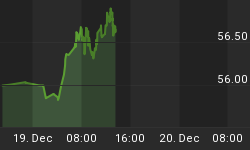Below is a commentary that originally appeared at Treasure Chests for the benefit of subscribers on Friday, February 23rd, 2007.
Today's report is about analysis of the US Dollar Index. Fibonacci time extensions of two different waves are shown midway on the chart and Fib price retracements of the most recent decline from November till December shown on the right hand side. The 61.8% retracement level was strong resistance, which sent the index down to test the 38.2% retracement level. The lower 55 MA Bollinger band is rising, with the upper 55 MA BB declining. This suggests we can expect to see the USD chopping sideways for 5-10 days before a sharp decline occurs. There is a Fib cluster around March 20th, suggestive that a bottom in the USD looms around this date. Short-term stochastics have the %K beneath the %D, with another 3-4 weeks at a minimum before a bottom is in place.
Figure 1
A Babson channel was drawn to contain the USD footprint of the decline since December 2005. The upper channel line has proven to be incredibly strong resistance, with the lower trend line some 10-15 points below the current level. Moving averages are in bearish alignment (200 day MA above the 155 day MA above the 50 day MA), with the 50 day MA acting as resistance at 84.384. Full stochastics have the %K beneath the %D, with another 4-6 weeks at a minimum before a bottom is put in place.
Figure 2
The weekly USD index is shown below, with Fib time extensions of the decline shown at the top of the chart Fib price retracements of the decline shown in red between 90 and 120 and Fib price projections also shown in red, with all levels below 80. The weekly chart really puts into perspective how long the downward trending line has been in force and the significance of failing to break above it. The only way the USD is going to rise is with a change in interest rate policies to be dollar supportive. Declining interest rates are only going to cause more people to look for other currencies. The lower 55 week MA Bollinger band is at 80.805, up from last week's value of 80.793, suggestive the USD is building a base before declining further. Full stochastics have the %K above the %D within the confines of a triangle. Should the %K break below the lower triangle trend line, look out below. The %K has curled over mid-way in the current range, which is bearish considering there was not enough internal strength to at least propel it to the declining upper trend line of the triangle.
Figure 3
The mid-term Elliott Wave chart of the USD index is shown below, with the thought path denoted in green. The exact position of the end of wave 1.(C ) could be as labeled, or else at the wave [iii] position. Until more of the wave structure presents itself, it is difficult to say how the wave structure will manifest itself. The trend however, based upon the current labeling scheme is down.
Figure 4
The long-term Elliott Wave chart of the USD Index is shown below, with the thought path denoted in green. Wave w was a double zigzag, with wave x thought to be forming a non-limiting triangle. Wave C.(W) and an internal wave structure of (X) were elongated flats, which usually occur in triangles. As such, these leads to the hypothesis that the current sideways action is forming some form of a triangle. The USD is likely to remain above 80 for the next two years, however, do not rule out a quick spike below. The global governments are propping up things and that can only work for so long. The short and skinny of this report: The USD has downside for the near future and this is going to add fuel to gold and silver moving higher. Gold is starting to move up against all other currencies, but as is starting to take on "currency-like" tendencies, it can expect to bob up and down in the currents of the eddies and waves created by the USD. By time the public "gets it", the price of gold is going to be north of $1200/ounce.
Figure 5
As a side note, there was a fire at a major oil refinery in Ontario, which caused it to be shut down. This has created severe fuel shortages in some parts of Ontario. This is a representative snapshot at how dependent we as North Americans are on oil. Most of the oil refineries we all have are 30 plus years old. As such, pressure your local governments to try to aid in refurbishing/building new refineries. Peak oil is a problem, but if there are no facilities to process the oil, it just compounds the problem.
Enjoy the day.















